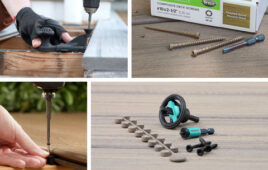By Darryl McBride, Engineering Manager, Smalley Steel Ring Company, Lake Zurich, Ill.
There are many factors to consider when designing retainer rings. Here are four that may help you.
Retaining rings are precision engineered parts that provide a shoulder for accurately positioning, locating, and retaining parts on shafts or in bores. Rings can be analyzed with a set of design calculations that take into consideration materials, load capacity, rotational capacity, and installation stress.

Spirolox retaining rings have no ears to interfere with mating components. They are coiled on edge to the exact diameter required.
The load capacity of a retaining ring assembly requires calculations for both ring shear and groove deformation. Load capacity equations do not take into account any dynamic or eccentric loading, but if this type of loading exists, the proper safety factor should be applied and the product tested. In addition, the groove geometry and edge margin (the distance of the groove from the end of the shaft or housing) should be considered. When operating under harsh conditions actual testing determines true ring performance.
Ring shear
Ring shear can constrain a design when hardened steel is used as a groove material. Use the following equation. The values are based on a shear strength of carbon steel with a recommended safety factor of three.

When permanent groove deformation occurs, the ring begins to twist and as the angle of the twist increases, the ring begins to enlarge in diameter.

The thrust load based on the ring shear must be compared to the thrust load based on groove deformation to determine which is the limiting factor in the design.
Groove deformation
Groove deformation can be the most common retaining ring design limitation. As the groove deforms, the ring begins to twist, and as the angle of twist increases, the ring begins to enlarge in diameter. Ultimately, the ring becomes dished and extrudes (rolls) out of the groove. The following equation calculates the point of initial groove deformation. This does not constitute failure, which occurs at a much higher value.


To assure maximum load capacity, it is important to have square corners on the groove and retained components.
Typical groove material yield strengths
Hardened steel 8620 110,000 psi
Cold drawn steel 1018 70,000 psi
Hot rolled steel 1018 45,000 psi
Aluminum 2017 40,000 psi
Cast iron 10,000 – 40,000 psi
Since ring shear was calculated at 44,787 lb, the groove yields before the ring shears. Therefore, 28,769 lb is the load capacity of the retaining ring.

The trust and load based on ring shear must be compared to the thrust load based on groove deformation to determine which one is the limiting factor in the design.
Rotational capacity
A retaining ring operating on a rotating shaft can be limited by centrifugal forces. When these forces are great enough to lift the ring from the groove, it may fail. The following equation calculates the speed at which the force holding the ring on the groove (cling) becomes zero. The retaining ring may fail when the assembly is accelerated rapidly.

Installation stress analysis
Standard parts that are assembled manually with the recommended shaft and groove diameters do not require stress analysis. To select a safe stress value, estimate the elastic limit of the raw material. The minimum tensile strength can be used as a suitable estimate. As with any theoretical calculation, a closer analysis of the actual application may reveal that these stress values can be exceeded. However, functional characteristics such as installation method, the number of times the ring will be installed and removed, thrust load, and/or centrifugal capacity must be considered.
After forming, the ring’s natural tendency is to return to its original state. This places the inner edge of the radial wall in residual tension and the outer edge in residual compression. To account for the residual stress in the ring when it expands only 80% of the minimum tensile strength should be used to compare to the installation stress. In special designs where the installation stress exceeds the material’s elastic limit, make ring diameters that will yield a predetermined amount during assembly. Once installed, the ring will have the proper cling (grip) on the groove.
Installation stress:

Since the installation stress is less than 80% of the minimum tensile strength, it will not take a permanent set.
Smalley’s website can help you configure your own retaining rings or wave springs. Simply enter the application requirements to design a custom part that can be manufactured to your specifications. Change the material, the operating cavity, and the wire properties to see how your design is affected. Print or submit your design directly to Smalley to verify that your design will work. This useful tool can be found at: www.smalley.com/retaining_rings/design_a_special.asp .
Discuss this on The Engineering Exchange:
Smalley Steel Ring Company
www.smalley.com
::Design World::





Tell Us What You Think!